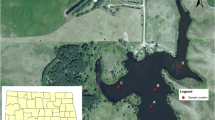Abstract
In July and August, 1974, measurements were made of the standing crops of Cladocera in the littoral zone of Par Pond (Savannah River Plant, Aiken, South Carolina, U.S.A.), which receives hyperthermal effluent from a nuclear reactor. Crops of Ceriodaphnia spp. and Diaphanosoma brachyurum were greater in the heated than in the ambient area, while Bosmina longirostris maintained higher standing crops in the ambient area than in the area receiving hyperthermal effluent. In August, 1974, exclosures were placed in the effluent-affected area to test the hypothesis that the high density of rooted aquatic macrophytes in the effluent-affected area influences the standing crop of these Cladocera. The effects of changes in reactor effluent temperature were also determined in the exclosure experiments. The results of the exclosure study support two generalizations: 1) the presence of dense rooted vegetation allows higher standing crops of Ceriodaphnia spp. and D. brachyurum; and 2) lower temperatures than those usually found at the heated station would favor B. longirostris standing crops, while the higher effluent temperatures favor Ceriodaphnia spp. and D. brachyurum.
Similar content being viewed by others
References
Bowen, M. A. 1975. Effects of a thermal effluent on the ostracods of Par Pond, South Carolina, Second Symposium on Thermal Ecology (in press).
Brauer, G. A., Neill, W. H. & Magnuson, J. 1974. Effects of a power plant on zooplankton distribution and abundance near plant's effluent, Water Res., 8: 485–489.
Brooks, J. L. 1969. Eutrophication and changes in the composition of the zooplankton, Eutrophication: Causes, Consequences, and Correctives. Nat. Acad. Sci. Publ. 1700: 236–255.
Cairns, J. 1971. Thermal pollution—a cause for concern. Water Pollution Control Fed. J., 43: 55–66.
Clugston, J. P. 1973. The effects of heated effluents from a nuclear reactor on species diversity, abundance, reproduction, and movement of fish, PhD Thesis, University of Georgia, Athens, Georgia, USA.
Fenlon, M. W., Mc Naught, D. C. & Schroeder, G. D. 1971. Influences of thermal effluents upon aquatic production in Lake Ontario, Proc. 14th Conf. Great Lakes Res., 21–26.
Gliwicz, Z. M. 1975. Effect of zooplankton grazing on photosynthetic activity and composition of phytoplankton, Verb. Internat. Verein. Limnol., 19: 1490–1497.
Grace, J. B. & Tilly, L. J. 1976. Distribution and abundance of submerged macrophytes including Myriophyllum spicatum L. (Angiospermae) in a reactor cooling reservoir, Archiv. fur Hydrobiologie (in press).
Marshall, J. S. & Tilly, L. J. 1971. Temperature effects on phytoplankton productivity in a reactor cooling pond, Radionuclides in Ecosystems, Proceedings on Radioecology, 645–651.
Patalas, K. 1970. Primary and secondary production in a lake heated by thermal power plant, Proc. Inst. Envir. Sci., 267–271.
Porter, K. 1973. Selective grazing and differential digestion of algae by zooplankton, Nature, 244: 179–180.
Siegel, S. 1956. Non-Parametric Statistics for the Behavioral Sciences, McGraw-Hill Book Company, New York, 312 pp.
Straskraba, M. 1965. The effect of fish on the number of invertebrates in ponds and streams, Mitt. Internat. Verein. Limnol., 13: 106–127.
Tilly, L. J. 1973. Comparative productivity in four Carolina lakes, Amer. Midl. Nat., 90: 356–365.
Tilly, L. J. 1974. Respiration and net productivity of the plankton community in a reactor cooling reservoir, Thermal Ecology (J. W. Gibbons and R. R. Sharitz, eds.), Technical Information Center, USERDA, Oak Ridge, Tennessee. pp. 462–474.
Werner, E. E. & Hall, D. J. 1974. Optimal foraging and the size selection of prey by the bluegill sunfish (Lepomis macrochirus), Ecol., 55: 1042–1052.
Zaret, T. M. 1975. Strategies for existence of zooplankton prey in homogeneous environments, Verb. Internat. Verein. Limnol., 19: 1484–1489.
Author information
Authors and Affiliations
Rights and permissions
About this article
Cite this article
Vigerstad, T.J., Tilly, L.J. Hyperthermal effluent Effects on heleoplanktonic Cladocera and the influence of submerged macrophytes. Hydrobiologia 55, 81–85 (1977). https://doi.org/10.1007/BF00034809
Received:
Issue Date:
DOI: https://doi.org/10.1007/BF00034809




